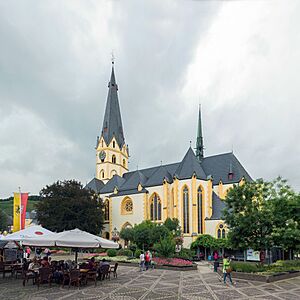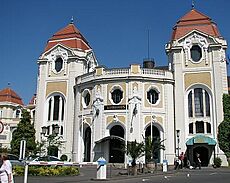Bad Neuenahr-Ahrweiler facts for kids
Quick facts for kids
Bad Neuenahr-Ahrweiler
|
||
|---|---|---|
 |
||
|
||
| Country | Germany | |
| State | Rhineland-Palatinate | |
| District | Ahrweiler | |
| Elevation | 99 m (325 ft) | |
| Population
(2022-12-31)
|
||
| • Total | 26,669 | |
| Time zone | CET/CEST (UTC+1/+2) | |
| Postal codes |
53474
|
|
| Dialling codes | 02641; 02646 | |
| Vehicle registration | AW | |
| Website | www.bad-neuenahr-ahrweiler.de | |
Bad Neuenahr-Ahrweiler is a special spa town in Germany. It's located in the state of Rhineland-Palatinate and is the main city of the Ahrweiler district. A big road called the A61 motorway connects it to larger cities like Cologne and Mainz.
This town was formed in 1969 when two towns, Bad Neuenahr and Ahrweiler, joined together. Today, Bad Neuenahr-Ahrweiler is made up of 11 smaller areas, or districts.
Contents
Exploring Bad Neuenahr-Ahrweiler's Geography
Bad Neuenahr-Ahrweiler is found in the beautiful Ahr valley, which is near the Rhine river in northern Rhineland-Palatinate. The town is nestled among the Ahr Hills.
The tallest hill nearby is called the Häuschen, standing at about 506 meters (1,660 feet) high. Other hills in the area include Steckenberg, Neuenahrer, and Talerweiterung. Long ago, there were castles on the Neuenahrer and Talerweiterung hills.
Towns and Villages Nearby
Bad Neuenahr-Ahrweiler is surrounded by several other towns and villages. These include Grafschaft, Remagen, Sinzig, Königsfeld, Schalkenbach, Heckenbach, Kesseling, Rech, and Dernau. The closest big cities are Bonn and Koblenz.
How the Town is Divided
Bad Neuenahr-Ahrweiler is split into areas called Ortsbezirke. Each Ortsbezirk has one or more smaller districts and is looked after by local councils. The largest district, Bad Neuenahr, was originally three separate communities.
Here's a look at the population of some districts as of June 30, 2015:
| Local District | Population |
|---|---|
| Ahrweiler | 7,411 |
| Bachem | 1,214 |
| Bad Neuenahr (including Beul, Hemmessen, and Wadenheim) | 12,132 |
| Gimmigen | 735 |
| Heimersheim (including Ehlingen) | 3,194 |
| Heppingen | 873 |
| Kirchdaun | 368 |
| Lohrsdorf (including Green) | 672 |
| Ramersbach | 567 |
| Walporzheim (including Marienthal) | 698 |
Weather in Bad Neuenahr-Ahrweiler
| Climate data for Bad Neuenahr-Ahrweiler (1991-2020) | |||||||||||||
|---|---|---|---|---|---|---|---|---|---|---|---|---|---|
| Month | Jan | Feb | Mar | Apr | May | Jun | Jul | Aug | Sep | Oct | Nov | Dec | Year |
| Record high °C (°F) | 16.9 (62.4) |
20.7 (69.3) |
25.4 (77.7) |
30.5 (86.9) |
33.4 (92.1) |
36.4 (97.5) |
40.4 (104.7) |
38.9 (102.0) |
34.5 (94.1) |
28.5 (83.3) |
22.4 (72.3) |
19.0 (66.2) |
40.4 (104.7) |
| Mean daily maximum °C (°F) | 5.9 (42.6) |
7.3 (45.1) |
11.4 (52.5) |
15.9 (60.6) |
19.8 (67.6) |
22.9 (73.2) |
25.2 (77.4) |
25.1 (77.2) |
20.7 (69.3) |
15.5 (59.9) |
10.0 (50.0) |
6.5 (43.7) |
15.5 (59.9) |
| Daily mean °C (°F) | 2.9 (37.2) |
3.5 (38.3) |
6.5 (43.7) |
10.2 (50.4) |
14.1 (57.4) |
17.2 (63.0) |
19.2 (66.6) |
18.7 (65.7) |
14.7 (58.5) |
10.5 (50.9) |
6.5 (43.7) |
3.6 (38.5) |
10.6 (51.1) |
| Mean daily minimum °C (°F) | −0.3 (31.5) |
−0.2 (31.6) |
2.1 (35.8) |
4.6 (40.3) |
8.4 (47.1) |
11.6 (52.9) |
13.5 (56.3) |
13.1 (55.6) |
9.6 (49.3) |
6.0 (42.8) |
2.9 (37.2) |
0.5 (32.9) |
6.0 (42.8) |
| Record low °C (°F) | −20.3 (−4.5) |
−21.8 (−7.2) |
−14.1 (6.6) |
−6.4 (20.5) |
−2.7 (27.1) |
1.6 (34.9) |
4.0 (39.2) |
4.5 (40.1) |
0.1 (32.2) |
−7.0 (19.4) |
−12.5 (9.5) |
−20.1 (−4.2) |
−21.8 (−7.2) |
| Average precipitation mm (inches) | 46.0 (1.81) |
42.0 (1.65) |
48.0 (1.89) |
39.0 (1.54) |
58.0 (2.28) |
60.0 (2.36) |
62.0 (2.44) |
64.0 (2.52) |
53.0 (2.09) |
49.0 (1.93) |
46.0 (1.81) |
53.0 (2.09) |
620.0 (24.41) |
| Source: wetterlabs.de: Bad Neuenahr-Ahrweiler | |||||||||||||
A Look Back at Bad Neuenahr-Ahrweiler's History

Ancient Times
People have lived and farmed in this area for a very long time. Discoveries from the Hallstatt period (around 1000–500 BC) show that Celts lived here. Later, during the Gallic Wars (58–50 BC), the native Eburones people were moved to the Middle Rhine. Many Roman items from the 1st to 3rd centuries have also been found, including a notable Roman villa.
The Middle Ages
In 893 AD, Ahrweiler was first mentioned in old records as "Arwilre." An abbey in Ahrweiler owned a large estate with farms and vineyards. The first mention of a church in the area of Neuenahr Castle was between 1204 and 1225. One of Germany's oldest inns, Gasthaus Sanct Peter, was founded here in 1246.
Modern Era
Between 1960 and 1972, a secret government bunker was built near Bad Neuenahr-Ahrweiler. It was hidden inside old railway tunnels. This bunker was kept ready for use for about 30 years. It was closed in 1997 and opened as a museum in 2008.
In 2021, the town experienced a very large flood. Many parts of the town were covered in water.
Economy: What Bad Neuenahr-Ahrweiler Makes and Does
- The German Army has a large underground storage facility here for its supplies.
- The town is famous for its "Heppinger" mineral water, which has been bottled since 1584.
- The "Apollinaris" mineral water company also started in Bad Neuenahr in 1852.
Getting Around: Transport
The town has five train stations on the Ahr Valley Railway. You can catch a train to Bonn every hour.
Sports in Bad Neuenahr-Ahrweiler
- The town is home to a very successful women's football team called SC 07 Bad Neuenahr.
Friends Around the World: Twin Towns
Bad Neuenahr-Ahrweiler is connected with another town as a "sister city":
 Brasschaat, Belgium
Brasschaat, Belgium
Famous People from Bad Neuenahr-Ahrweiler
- Cyrillus Jarre (1878–1952), a Franciscan Archbishop.
- Markus Stenz (born 1965), a conductor.
- Björn Glasner (born 1973), a cyclist.
- Jan van Eijden (born 1976), a cyclist.
- Pierre Kaffer (born 1976), a racing driver.
- Bianca Rech (born 1981), a footballer.
- Ricarda Funk (born 1992), a canoeist.
People Connected to the Town
- Karl Marx (1818–1883), a famous philosopher, stayed in a spa resort here in 1877.
- Ludwig van Beethoven (1770–1827), a famous composer, is believed to have visited the town when he was young.
- Peter Friedhofen (1819–1860), who founded a charitable group, worked in Ahrweiler.
- Wolfgang Müller von Königswinter (1816–1873), a writer, died in Bad Neuenahr.
- Blandine Merten (1883–1918), a nun, lived near Ahrweiler.
- Ebba Tesdorpf (1851–1920), an artist, died in Ahrweiler.
- Paul Metternich (1853–1934), a diplomat, died in the Heppingen district.
- Max von Schillings (1868–1933), a composer and conductor.
- Christian Hülsmeyer (1891–1957), an inventor, died in Ahrweiler.
See also
 In Spanish: Bad Neuenahr-Ahrweiler para niños
In Spanish: Bad Neuenahr-Ahrweiler para niños







